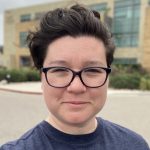LA JOLLA, CA—Behind every scientific paper from La Jolla Institute for Immunology (LJI) labs is a team of highly skilled scientists from LJI’s Research Services. These research “cores” provide valuable tools and extremely specialized expertise to LJI researchers and to the Institute’s many research partners.
So it was a big deal this Fall when Next Generation Sequencing Core Director Suzie Alarcón, Microscopy and Histology Core Director Zbigniew Mikulski, Ph.D., and Histopathology Core Director Kenneth Kim, Dipl. ACVP, teamed up to bring an entirely new service to LJI: the Nanostring GeoMx DSP.
This sci-fi-sounding machine will let researchers delve into a rapidly evolving field of immunology called spatial transcriptomics.
The spatial part is easy to understand. Scientists need to know where disease processes are taking place—which tissues, and which areas of those tissues, are hit by autoimmune diseases, viruses, etc. Kim and Mikulski are specialists in this kind of tissue imaging and analysis. As a histopathologist, Kim uses a pinkish/purple stain (called an H&E stain) to distinguish cell types in a tissue from each other. Mikulski’s colleagues in Microscopy and Histology have methods to take images and videos of cells, often with the addition of fluorescent proteins or tags.
As Kim explains, the Nanostring GeoMx DSP is a major leap forward for the Institute. The machine will help researchers better focus on specific areas where immune cells are at work within larger tissue samples. “When you’re working with a tissue sample, it’s like starting with a low resolution view of the whole world,” says Kim. “What labs here want to do is just look around a neighborhood.”
Once they narrow down where to look for disease processes, Alarcón’s team in the Next Generation Sequencing Core can use the Nanostring GeoMx DSP to analyze exactly what immune cells are up to. This is the “transcriptomics” or “proteomics” part of the work.
Cells don’t really use the genome like a big set of instructions. Instead, machinery inside cells activates select genes as needed. A cell reads these genes and “transcribes” them into the RNA code needed to build specific proteins. So a “transcriptome” describes the set of genomic sequences a cell is actually busy using.
For example, a T cell in a healthy lung would have a very different transcriptome than a T cell from a lung in a person suffering from severe COVID-19. Immune cells need to transcribe different genomic sequences to respond to different health issues. By comparing these transcriptomes, a researcher might see which proteins the cell is attempting to use to fight severe infection.
In fact, the Nanostring GeoMx DSP is powerful enough to probe the whole transcriptome of an organism—revealing virtually every transcript that a human or a mouse is making. This kind of broad, unbiased probe is critical for uncovering new and unexpected aspects of the immune response.
With the Nanostring GeoMx DSP, Alarcón and her colleagues can take the cells that Kim and Mikulski have identified and assist scientists in studying their transcriptomes at the subcellular level. The results could reveal exactly where and exactly how cells respond to disease processes.
“This is really interesting for us because it involved more than two LJI Cores working together,” says Alarcón.
“I think we’re all super excited to help labs here get into the field of spatial-omics,” adds Kim.
These three Cores are now training LJI scientists to use the Nanostring GeoMx DSP in their studies. As always, these Core directors and their staffs are on hand to answer questions and help guide data collection.
More from LJI Cores:
Get to know Kenneth Kim, the man with the microscope
LJI team wins $500,000 XPRIZE for COVID-19 screening protocol




